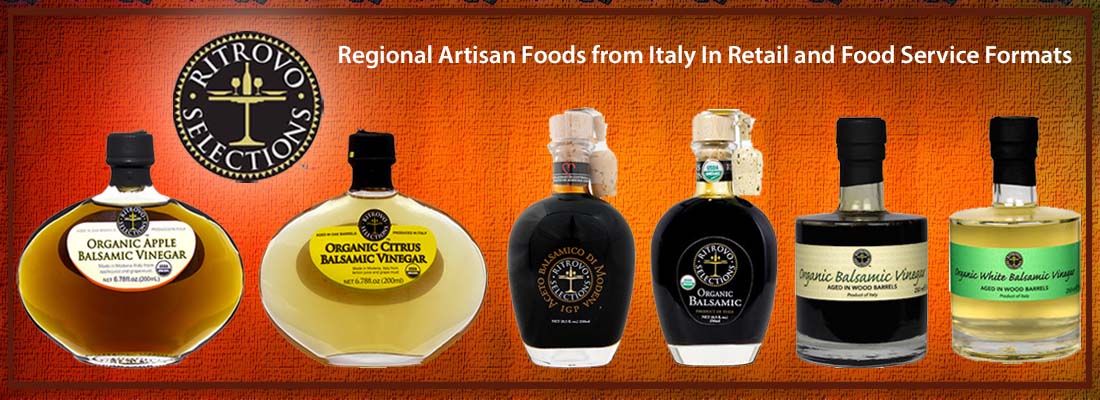
This Is Great Video On How Tradizionale Balsamic Vinegar Is Made
The House of Malpighi is famous for Tradizionale the true Balsamic Vinegar of legend. Affinato and Extra Vecchio are the younger versions aged in a variety of barrels for 12 & 25 years. There are also 50, 80 and 100 year old versions. These are very expensive ranging from $100-$600 for a 100 ml. bottle. You may be asking yourself what do you do with a 100 year old Balsamic Vinegar? Well you put a drop on a porcelain spoon and enjoy it as a digestif after your meal.
You will not see Tradizionale on the shelf very often however if you ever have a desire to try one of these extraordinary marvels of culinary history just ask the retailer who sent you here to special order one for you!
Malpighi was one of the first to get the “Condimento Grade” of Balsamic Vinegar down to a science. Their Saporoso starts off life just like Tradizionale but only spends 6-8 years in barrels. It is then put in stainless steel tanks where it is stirred which accelerates the reduction process. You end up with a condiment that tastes almost as good as its older cousins but is a fraction of the price. They do a 6 year and an 8 year Riserva. The 8 year pours like syrup and is great for decorating plates. Balsamic Vinegar is a flavor enhancer you add it to all sorts of recipes and you finish meats, seafood, vegetables and desserts with it.
Malpighi also offers their 5 and 8 year old Prelibato which are White Balsamic Vinegar. They are a really nice balance of sweetness and acidity. Rather than being caramelized in open pots the must is reduced in a centrifuge so it retains the light color of the Trebbiano grapes. It does take on some color from the time they spend in barrels the 8 year old more so than the 5. These are great for dressing seafood, fruit salads and make a wonderful vinaigrette ( see the basic vinaigrette recipe).

Our Condimento Styles of Balsamic Vinegar are either made entirely of grape must or grape must and wine vinegar. These are truly artisan made by very innovative makers. This is a premium IGP grade with much stricter rules than the lower classification.

Originally form Modena, Sopraffino predates Balsamic Vinegar. It is made from Cabernet, Merlot and Raboso grapes. The family now grows grapes and makes this extraordinary vinegar in the Northern Veneto. The reduction of the must is accomplished gently at much lower temperatures than Balsamic Vinegar. The 12 year is very much like its cousin Tradizionale Affinato but not quite as sweet. At half the price it is one of the great bargains in Italy. You could use it in a salad dressing but it is better suited as a flavor enhancer in stews sauces and soups or to drizzle on meats of vegetables dishes as a finishing sauce. It’s about $60 in stores.
Vinagro is a special wine vinegar where the maker blends in just a bit of reduced grape must. It softens the acidity with just a touch of sweetness that results in a vinegar with beautiful balanced flavor. There is white vinegar made from Pinot Grigio, a red from Cabernet and a Spicy Vinagro that they have added a bit of chili. These run about $12 in stores and are just fabulous for salads, marinades, and just about any food or dish that requires a bit of acidity.
Everything You Need To Know About Wine & Balsamic Vinegar
It is important to know that the higher classifications of Balsamic Vinegar are different than what most consumers normally encounter. Tradizionale is truly rare and expensive at around $100 for a 12 year ranging to $600 for a 100 year. It is made of 100% grape must. Grape must is made by crushing whole grape clusters, skins, seeds, stems and all that is then reduced and caramelized by cooking it down in large kettles. Tradizionale carries a DOP stamp which certifies that it made according to specific practices and ingredients. None have spent less than 12 years aging in a series of wood barrels.
Our Balsamic Condimento grades from Malpighi are also made from 100% grape must. However, the rules of the IGP (not as strict as DOP) that governs Condimento grades and allow the makers to also incorporate wine vinegar into their recipes. So both Pedroni and ReModena use grape must and wine vinegar in their Condimento vinegar to great effect. The IGP has very strict rules that must be adhered to for Condimento grades but they can be made in half the time of true Balsamic Tradizionale which brings the cost down to less than half for some really excellent products.
Aceto Balsamico di Modena IGP which is the third classification has a really great name but the rules are really broad. Some of the vinegar made under these rules are very good. Others not so great because coloring agents, thickeners and flavors are allowed to be incorporated in the product’s production.
I always tell clients and friends to look at the label. If there is anything on the ingredient list other than grape must and wine vinegar better to buy something else. The vast majority of vinegar you will find in this classification is not very good especially in terms of the ingredients. I was on a website the other day where the writers elevated the Aceto Balsamico di Modena IGP classification and a particular product above Condimento grades which is a total misconception.








